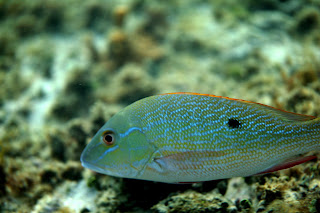Martha and I walked the dog, packed the Jeep and left for the beach at 6:35 am. I forgot to get a new mask strap last night so I used my spare mask, which is clear. I had some trouble framing and focusing photographs, but I worked through it. The sun did not rise until 7:04 am and there were plenty of clouds to block the sun during the dive, so I kept the ISO at 800 - 1000 for most of the dive.
We got our gear on and locked up the Jeep at about 7:00 am and walked into the calm and quiet water to swim out to the Jacks. It took a few minutes to notice that there was a strong North current. I kicked as hard as I could and thought I should have made progress to the South but I would look over at the lamp and chimney and see that I had not. We would have been better off starting off at Tower 2, but we didn't. Once we got over the sand we descended at 7:47 am. Spotted a Gray Angelfish (Pomacanthus arcuatus) as soon as we got on the bottom.
I recognized our position from earlier dives but we never got on the three tiered reef. I remember only that we went East from that point quite a ways before turning South to get to the Jacks. So we headed off to the South and Martha spotted some single Jacks. We soon spotted the Jacks. We were at the NE end of the Jacks and there was a large area of excavation that I had not seen before.
So we headed South to see if these were new Jacks or not. They were not.
The Cave/Canyon the Nurse Sharks often sleep in was familiar to both of us. Looks like somebody drove their ship into the side of the reef. Maybe spend some more time exploring that later. The sun was up, so I backed off the ISO to 250; shutter speed at 400 and aperture at 2.8.
Got a shot of a Sergeant Major (Abudefduf saxatilis) where the Jacks started.
Got a nice shot of a Yellowfin Mojarra (Gerres cinereus)
a shot of a Bar Jack
(Caranx ruber)
a shot of a Striped Parrotfish (Scarus iserti)
a good shot of a Hogfish (Lachnolaimus maximus)
a Spotted Goatfish (Pseudupeneus maculatus)
a Yellow Goatfish (Mulloidichthys martinicus)
Saw some smaller and maybe younger Black Margates(Anisotremus surinamensis) as well as a Black Margate with his spines extended.
a shot of an Atlantic Spadefish (Chaetodipterus faber)
got a shot of a single Rock Beauty (Holacanthus tricolor) in the Jacks
We left the Jacks at 8:54 am and headed West to the beach. I didn't see much to photograph until about 9:21 am when I spotted a Lesser Electric Ray (Narcine brasiliensis) on the rubble. I got 3 quick shots then looked for Martha. When I turned back, the Ray was gone. I searched for a bit, but never say him again.
I took some final pictures of a Juvenile Blue Tang
(Acanthurus coeruleus)
and what I think is a Mutton Snapper (Lutjanus analis) .
I then secured the camera as we headed over the sand to the beach. We surfaced inside the buoy line at 9:57 am in about 5 feet of water. The first thing
I heard was thunder. A dark black cloud was coming up from the South so we hurried to get across the beach and up to the parking lot. Timing was perfect if it seemed to close at the time.
Out dive time was 130 minutes at a maximum depth of 23.8 feet. My Actual Consumption was 22.18 psi/minute; my Surface Consumption Rate was 14.94 psi/minute and my Residual Minute Volume was .39 cubic feet per minute.
























